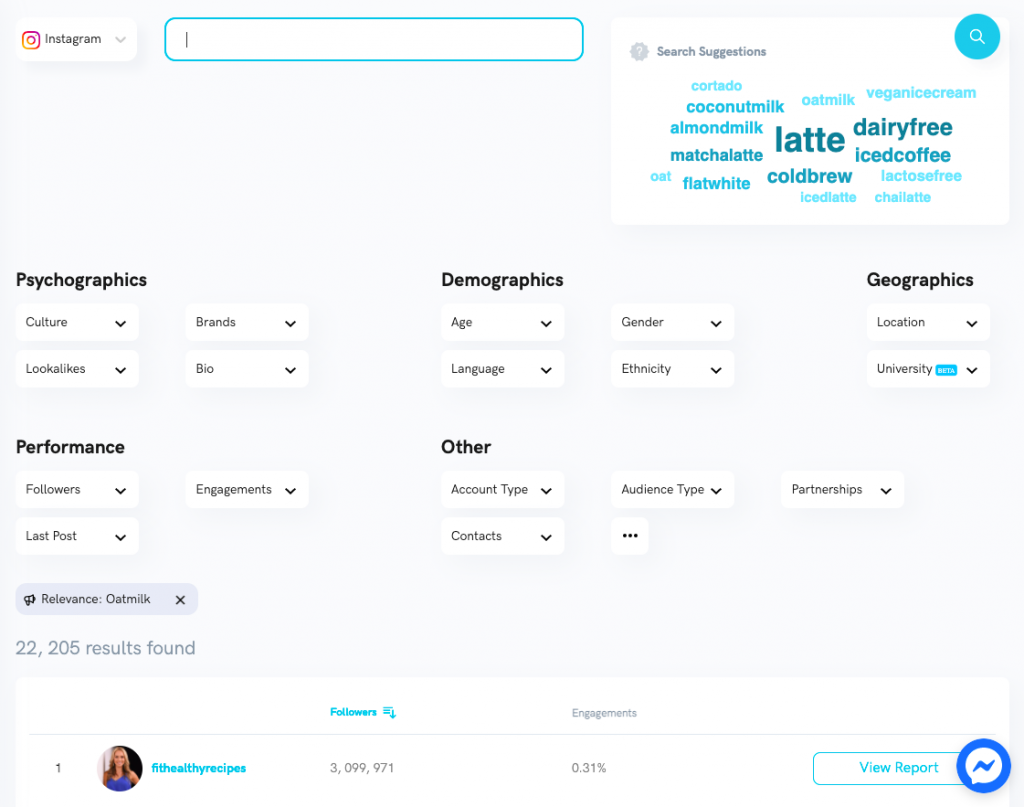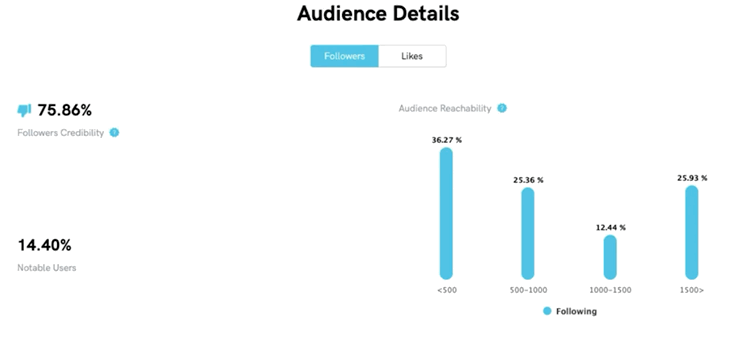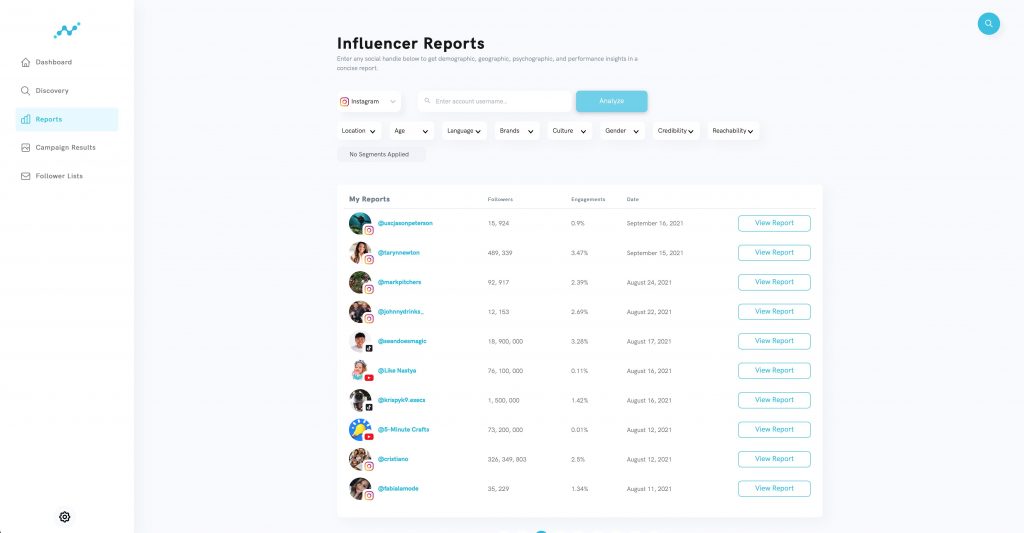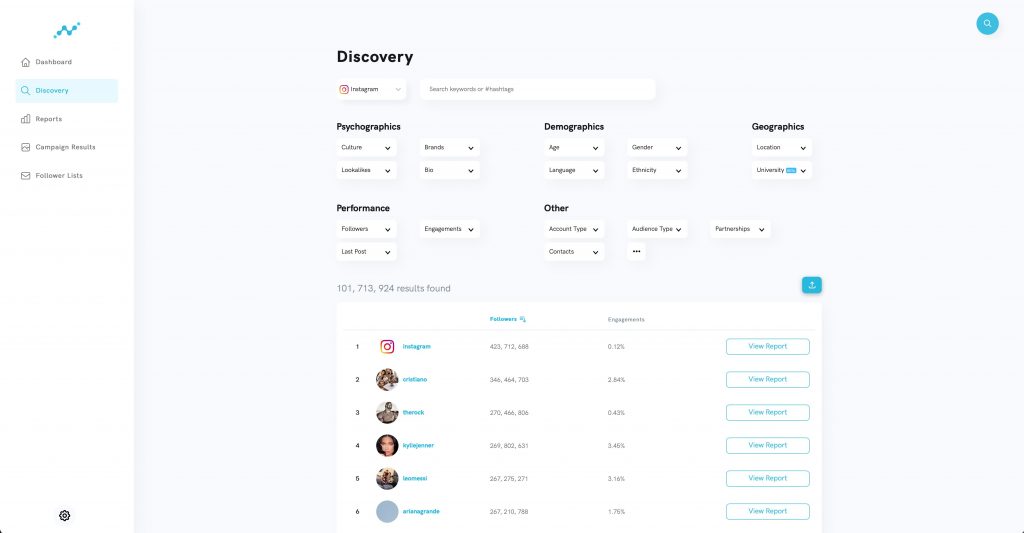
Services Offered:Search/DiscoveryCampaign ReportingInfluencer AnalysisAudience Analysis
Everything old is new again.
When we first launched Influencer Marketing Hub in 2016, the options for software leaned heavily toward Discovery. We looked at a lot of different search-only tools, half of which billed themselves as “The Google of Influencer Marketing.” As time marched on, many of these tools found they needed to add more and more features to remain competitive. Even one of the best platforms out there—NeoReach, which had no equals in terms of search capabilities and influencer analytics—realized it needed to move past its uni-tasking ways to maintain its leadership position.
But everyone who needs to search for and understand influencers isn’t in need of a full end-to-end suite of tools to manage their marketing efforts from start to finish. For a variety of reasons, some people just need to find influencers and don’t want to pay for all these additional features. One of those people was Musa Sulejmani, founder and CEO of a company called Volume Apps. As a software development studio, VolumeApps didn’t need full marketing suites to get their products out to new users. They had no need for influencer relationships, big campaigns and all the attendant reporting and data around influencer performance. They just needed to find the exact right influencers to help spread the word about whatever app they were pushing. Success was measured in downloads, not engagement.
Finding the right platform to find the right influencer was a hassle. Too many features; too much upselling. But the proverbial straw that broke the developer’s back was getting scammed by an influencer he’d found who just didn’t have the audience he claimed. Unable to find a lightweight search tool with accurate data and insights into audiences, Sulejmani did what any app developer would do: he made his own.
That was in 2018. Now it’s 2021, and search-only tools are harder to find. Some makers of platforms are even saying that Discovery is dead, and declaring that feature as something unnecessary but nice to have. Some are leaving it out entirely. But some other companies are finding that this push to do All The Things limits their chances with prospective customers who just want a reliable way to find quality influencers with relevant audiences.
One of those companies rethinking the all or nothing strategy is Neoreach. Their own software is still top-notch, but that didn’t prevent them from buying Tensor. When one of the veterans in the space, an innovator in the field of search and discovery, buys your search and discovery tool, you know you’ve done something right.
Tensor Social Review:
Pricing
的一个主要吸引了张量的能力to neatly fit into any sized business. As you’ll read in The Details, the analytics go deep—making this an excellent tool even for the biggest of brands. But as you’ll see in this section, it’s well within any budget.
- Free, $0/mo —Includes 1 influencer report, and only shows the top 3 results of your search
- Entry, $49/mo —10 reports, top 3 results
- Standard, $249/mo —50 reports, 1,500 Discover Exports, Tensor Lists, Post Analysis, API Access
- Premium, $749/mo —Sames as above, except with 200 reports, 5,000 Export
As you can see, there isn’t a business that exists that can’t afford one of these plans (Seriously, if you can’t affordFreeit means you’ve already had your assets seized). But there is one sore spot here, and that’s the limit on the results in theEntryplan. I get why limits like these are put in place, but at least make it equal to the number of reports you can run.
There are so many ways to filter your searches that Tensor will keep coming back with different results in the top 3—and you can keep changing your search ever so slightly each time until you find the 10 influencers you want to run reports on. Regardless of the number of results you get, you’re still ending the month having run 10 reports, so all this limit does is make it harder for you to use the software.
The Details
Tensor’s ingenuity is apparent from the very first keyword you type into its search field and submit. It’s only a matter of a second or two before you’re served tens of thousands of results from its database of over 100 million influencers—and that’s not the cool part. The notable thing here is you’ll also get a word cloud of search suggestions, other keywords and hashtags that are related to your search that might uncover similar results/influencers.

From here you can keep filtering your results down by a number of filters and apply them to the influencers, their audiences, or both. Every additional criteria you define refreshes and narrows the list of results, andalso更新搜索建议。这给你一个little window into how Tensor is searching. It’s definitely not matching your search terms to words found in an influencer’s bio: there’s a filter just for that. Instead, it matches them to text within the post itself, with the AI behind the algorithm analyzing frequency of use and making determinations of the influencer’s overall relevance within the context of everything they’re posting. These search suggestions that pop up appear to be some of the contextual clues the AI uses to understand the influencer.
But back to the filtering. There are standard demographics by which you can filter—age, gender, location, language, and ethnicity—but it’s the psychographic filters where Tensor really shines. Interests and brand affinities are two of the biggest deals, and for each you can search for matching influencers, or influencers with matching audiences. Each of the additional criteria can be weighted, too, preventing you from missing out on results that might not be exact but are matches in more important ways.

从这些结果可以继续运行a report for the full scoop on the influencer. You’re not given a hell of a lot of information to go on before deciding to view the report—just the account name, follower count, and engagement rate—but you are definitely given all the information once you commit to that report. The reports are exhaustive, a deep dive into the influencers in question and their audiences. There are the expected bits of information you’d get from any report, like Average Likes, Engagement Rate, popular hashtags, and frequent mentions. There are less common place entries, such as lookalike influencers, notable followers, interested and affinities for both influencer and audience. And there are things that are unique to Tensor, like the ability to look at their audience from two different perspectives: their followers vs. their likers.

The profile will also take you into the influener’s posts, both the three most popular ones and the three most recent sponsored posts. While there’s no feature to export these reports to PDF, it is very easy to share the profile report with anyone. Just click a button and you’re given a link to copy, paste, and share (like this: go look at areport).

You can, on the other hand, export and share the results of your searches, which includes much more information than you see on the results screen. Links to their other social profiles and their email addresses for contacting are two notable inclusions. Currently this report only exports to CSV, but integrations with Google Sheets and Hubspot are imminent (if not already released by the time this review is published). After that are plans to integrate into Salesforce and Mailchimp.
The platform also provides a way to organize your favorite influencer discoveries into lists, a self-explanatory feature that needs no explanation beyond letting you know it does that. There is also a Campaign Results tool, though this will likely not be most marketers' go-to choice. It’s not that the reports aren’t informative—they are, with much of the same demo- and psychographic data you get out of the influencer reports. But it’s not an automatic reporting tool; you need to manually enter the URL for the post (Instagram only) that you want a report on. Small companies running small campaigns will find much to like about it, but any other brand already running its own campaign management software is getting automatic reporting on those campaigns. It’s a nice bonus feature, but isn’t the reason you’d be looking to Tensor to begin with. The search is the main attraction, by design and in practice.

Conclusion
Tensor Social’s goal with the platform was to create a lightweight, purpose-built application for brands who didn’t need any of the other more advanced features found in most influencer marketing platforms. They succeeded in that, for sure, and then moved past that goal post by creating something that would be of use to brands already using those end-to-end platforms for discovery (and everything else).
In all but the most extreme cases, Tensor’s database of over 100 million influencer accounts across Instagram, YouTube, and TikTok far surpasses what competitive search tools offer. And for the rare few that do offer that much choice, Tensor’s reporting is hard to match. The data and insights fuel top-notch business intelligence, which seems appropriate. Brands who won’t give this one a whirl are clearly lacking in it.
188金宝搏反水比例
- Features
- Ease of Use
- Reporting

Services Offered:Search/DiscoveryCampaign ReportingInfluencer AnalysisAudience Analysis


